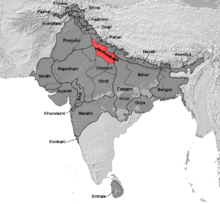හින්දුස්ථානී බස
| හින්දුස්ථානී | |
|---|---|
| හින්දි-උර්දු | |
| |
 The word Hindustani in the Devanagari and Perso-Arabic (Nastaliq) scripts | |
| උච්චාරණය | IPA: [ɦɪndʊstaːniː] |
| ස්වදේශික වන්නේ | ඉන්දියාව සහ පකිස්ථානය |
| කලාපය | හින්දි තීරුව (උතුරු ඉන්දියාව), ඩෙකෑන්, පකිස්ථානය |
ස්වදේශික හසුරුවන්නන් | ආසන්න වශයෙන් මිලියන 250 (2011 සහ 2017 සංගණන)[1] L2 speakers: ~500 million (1999–2016)[1] |
ඉන්දු-යුරෝපීය
| |
ආදි ස්වරූප | Shauraseni Prakrit
|
සම්මත ස්වරූප | නූතන සම්මත හින්දි
නවීන සම්මත උර්දු
|
| උපභාෂා |
|
ලේඛන ක්රමය | |
Signed forms | Indian Signing System (ISS)[5] |
| නිල තත්ත්වය | |
නිල භාෂාව වන ජාතිය | |
| යාමනය කරනු ලබන්නේ | |
| භාෂා කේත | |
| ISO 639-1 | hi – හින්දිur – උර්දු |
| ISO 639-2 | hin – හින්දිurd – උර්දු |
| ISO 639-3 | Either:hin – Hindiurd – Urdu |
| ග්ලොටෝලොග් | hind1270[9] |
| ලින්ග්වාස්ෆියර් | 59-AAF-qa to -qf |
 හින්දුස්ථානි (දෙල්ලාවි හෝ කෞරවි ස්වදේශීය භාෂාව වන ප්රදේශ රතු මගින් දක්වා ඇත.) | |
හින්දුස්ථානි (/ˌhɪndʊˈstɑːni/; දේවනාගරි: हिन्दुस्तानी,[10][b] Hindustānī; පර්සෝ-අරාබි:[c] ہندوستانی, Hindūstānī, වාචික Hindustan)[11][3] උතුරු සහ මධ්යම ඉන්දියාව සහ පකිස්ථානය හි භාවිතා වන පොදු හෙවත් සබැදි භාෂාවකි.[12][13] හින්දුස්ථානි යනු හින්දි සහ උර්දු ලෙස හඳුන්වන සම්මත ලේඛන දෙකක් සහිත බහු කේන්ද්රීය භාෂාවකි. මේ අනුව, භාෂාව සමහර විට හින්දි-උර්දු ලෙස හැඳින්වේ.[14][15][16] මෙම සම්මත ලේඛන තිබියදීත්, හින්දුස්ථානි භාෂාවේ වාචික කථාව බොහෝ විට මෙම ප්රමිතීන් අතර වර්ණාවලියක් මත පවතී.[17][18]
මූලාශ්ර
- ^ a b "Hindi" L1: 322 million (2011 Indian census), including perhaps 150 million speakers of other languages that reported their language as "Hindi" on the census. L2: 274 million (2016, source unknown). Urdu L1: 67 million (2011 & 2017 censuses), L2: 102 million (1999 Pakistan, source unknown, and 2001 Indian census): Ethnologue 21. Hindi at Ethnologue (21st ed., 2018)
 . Urdu at Ethnologue (21st ed., 2018)
. Urdu at Ethnologue (21st ed., 2018)  .
.
- ^ a b Cite warning:
<ref>tag with nameGriersoncannot be previewed because it is defined outside the current section or not defined at all. - ^ a b c Ray, Aniruddha (2011). The Varied Facets of History: Essays in Honour of Aniruddha Ray (ඉංග්රීසි බසින්). Primus Books. ISBN 978-93-80607-16-0.
There was the Hindustani Dictionary of Fallon published in 1879; and two years later (1881), John J. Platts produced his Dictionary of Urdu, Classical Hindi and English, which implied that Hindi and Urdu were literary forms of a single language. More recently, Christopher R. King in his One Language, Two Scripts (1994) has presented the late history of the single spoken language in two forms, with the clarity and detail that the subject deserves.
- ^ Gangopadhyay, Avik (2020). Glimpses of Indian Languages. Evincepub publishing. p. 43. ISBN 9789390197828.
- ^ Norms & Guidelines සංරක්ෂණය කළ පිටපත 13 ජනවාරි 2014 at the Wayback Machine, 2009. D.Ed. Special Education (Deaf & Hard of Hearing), [www.rehabcouncil.nic.in Rehabilitation Council of India]
- ^ The Central Hindi Directorate regulates the use of Devanagari and Hindi spelling in India. Source: Central Hindi Directorate: Introduction සංරක්ෂණය කළ පිටපත 15 අප්රේල් 2010 at the Wayback Machine
- ^ "National Council for Promotion of Urdu Language". www.urducouncil.nic.in.
- ^ Zia, K. (1999). Standard Code Table for Urdu සංරක්ෂණය කළ පිටපත 8 අප්රේල් 2019 at the Wayback Machine. 4th Symposium on Multilingual Information Processing, (MLIT-4), Yangon, Myanmar. CICC, Japan. Retrieved on 28 May 2008.
- ^ Nordhoff, Sebastian; Hammarström, Harald; Forkel, Robert; Haspelmath, Martin, eds. (2013). "Hindustani". Glottolog 2.2. Leipzig: Max Planck Institute for Evolutionary Anthropology.
{cite book}: Invalid|display-editors=4(help); Unknown parameter|chapterurl=ignored (help) - ^ *McGregor, R. S., ed. (1993), "हिंदुस्तानी", The Oxford Hindi-English Dictionary, Oxford University Press, p. 1071, "2. hindustani [P. hindustani] f Hindustani (a mixed Hindi dialect of the Delhi region which came to be used as a lingua franca widely throughout India and what is now Pakistan"
- "हिंदुस्तानी", बृहत हिंदी कोश खंड 2 (Large Hindi Dictionary, Volume 2), केन्द्रीय हिंदी निदेशालय, भारत सरकार (Central Hindi Directorate, Government of India), p. 1458, http://www.chdpublication.mhrd.gov.in/ebook/b101/html5forpc.html?page=0, ප්රතිෂ්ඨාපනය 17 October 2021
- Das, Shyamasundar (1975), Hindi Shabda Sagar (Hindi dictionary) in 11 volumes, revised edition, Kashi (Varanasi): Nagari Pracharini Sabha, p. 5505, https://dsal.uchicago.edu/cgi-bin/app/dasa-hindi_query.py?page=5505, "हिंदुस्तानी hindustānī३ संज्ञा स्त्री॰ १. हिंदुस्तान की भाषा । २. बोलचाल या व्यवहार की वह हिंदी जिसमें न तो बहुत अरबी फारसी के शब्द हों न संस्कृत के । उ॰—साहिब लोगों ने इस देश की भाषा का एक नया नाम हिंदुस्तानी रखा । Translation: Hindustani hindustānī3 noun feminine 1. The language of Hindustan. 2. That version of Hindi employed for common speech or business in which neither many Arabic or Persian words nor Sanskrit words are present. Context: The British gave the new name Hindustani to the language of this country."
- Chaturvedi, Mahendra (1970), "हिंदुस्तानी", A Practical Hindi-English Dictionary, Delhi: National Publishing House, "hindustānī hīndusta:nī: a theoretically existent style of the Hindi language which is supposed to consist of current and simple words of any sources whatever and is neither too much biassed in favour of Perso-Arabic elements nor has any place for too much high-flown Sanskritized vocabulary"
- ^ "About Hindi-Urdu". North Carolina State University. 15 අගෝස්තු 2009 දින මුල් පිටපත වෙතින් සංරක්ෂණය කරන ලදී. සම්ප්රවේශය 9 අගෝස්තු 2009.
- ^ Mohammad Tahsin Siddiqi (1994), Hindustani-English code-mixing in modern literary texts, University of Wisconsin, https://books.google.com/books?id=vnrTAAAAMAAJ, "... Hindustani is the lingua franca of both India and Pakistan ..."
- ^ "Hindustani language". Encyclopedia Britannica. 1 November 2018. සම්ප්රවේශය 18 October 2021.
(subscription required) lingua franca of northern India and Pakistan. Two variants of Hindustani, Urdu and Hindi, are official languages in Pakistan and India, respectively. Hindustani began to develop during the 13th century CE in and around the Indian cities of Delhi and Meerut in response to the increasing linguistic diversity that resulted from Muslim hegemony. In the 19th century its use was widely promoted by the British, who initiated an effort at standardization. Hindustani is widely recognized as India's most common lingua franca, but its status as a vernacular renders it difficult to measure precisely its number of speakers.
- ^ Trask, R. L. (8 August 2019), "Hindi-Urdu", Dictionary of Historical and Comparative Linguistics, Edinburgh University Press, pp. 149–150, , https://books.google.com/books?id=jacxEAAAQBAJ&pg=PA149, "Hindi-Urdu The most important modern Indo-Aryan language, spoken by well over 250 million people, mainly in India and Pakistan. At the spoken level Hindi and Urdu are the same language (called Hindustani before the political partition), but the two varieties are written in different alphabets and differ substantially in their abstract and technical vocabularies"
- ^ Crystal, David (2001), A Dictionary of Language, Chicago: University of Chicago Press, , https://books.google.com/books?id=3GU5FWs1pBEC, "(p. 115) Figure: A family of languages: the Indo-European family tree, reflecting geographical distribution. Proto Indo-European>Indo-Iranian>Indo-Aryan (Sanskrit)> Midland (Rajasthani, Bihari, Hindi/Urdu); (p. 149) Hindi There is little structural difference between Hindi and Urdu, and the two are often grouped together under the single label Hindi/Urdu, sometimes abbreviated to Hirdu, and formerly often called Hindustani; (p. 160) India ... With such linguistic diversity, Hindi/Urdu has come to be widely used as a lingua franca."
- ^ Gandhi, M. K. (2018). An Autobiography or The Story of My Experiments with Truth: A Critical Edition. Translated by Desai, Mahadev. annotation by Suhrud, Tridip. New Haven and London: Yale University Press. ISBN 9780300234077.
(p. 737) I was handicapped for want of suitable Hindi or Urdu words. This was my first occasion for delivering an argumentative speech before an audience especially composed of Mussalmans of the North. I had spoken in Urdu at the Muslim League at Calcutta, but it was only for a few minutes, and the speech was intended only to be a feeling appeal to the audience. Here, on the contrary, I was faced with a critical, if not hostile, audience, to whom I had to explain and bring home my view-point. But I had cast aside all shyness. I was not there to deliver an address in the faultless, polished Urdu of the Delhi Muslims, but to place before the gathering my views in such broken Hindi as I could command. And in this I was successful. This meeting afforded me a direct proof of the fact that Hindi-Urdu alone could become the lingua franca<Footnote M8> of India. (M8: "national language" in the Gujarati original).
- ^ Basu, Manisha (2017). The Rhetoric of Hindutva (ඉංග්රීසි බසින්). Cambridge University Press. ISBN 978-1-107-14987-8.
Urdu, like Hindi, was a standardized register of the Hindustani language deriving from the Dehlavi dialect and emerged in the eighteenth century under the rule of the late Mughals.
- ^ Gube, Jan; Gao, Fang (2019). Education, Ethnicity and Equity in the Multilingual Asian Context (ඉංග්රීසි බසින්). Springer Publishing. ISBN 978-981-13-3125-1.
The national language of India and Pakistan 'Standard Urdu' is mutually intelligible with 'Standard Hindi' because both languages share the same Indic base and are all but indistinguishable in phonology and grammar (Lust et al. 2000).
පාද සටහන්
- ^ Not to be confused with the Bihari languages, a group of Eastern Indo-Aryan languages.
- ^ Also written as हिंदुस्तानी
- ^ This will only display in a Nastaliq font if you will have one installed, otherwise it may display in a modern Arabic font in a style more common for writing Arabic and most other non-Urdu languages such as Naskh. If this پاکستان and this پاکستان looks like this پاکستان then you are not seeing it in Nastaliq.